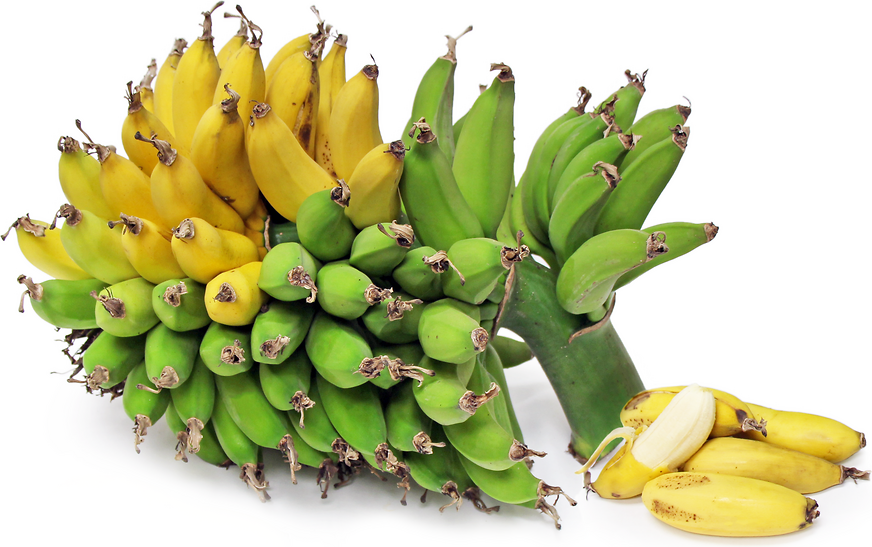


Rajapuri Bananas
Estimated Inventory, lb : 0
Description/Taste
Rajapuri bananas are small to medium-sized fruits, averaging 15 to 17 centimeters in length, and have a cylindrical, straight to slightly curved shape with pointed ends. The fruits form in large bunches, weighing up to 40 pounds, and grow in an upright pattern. The skin is smooth and thin, easily peeled when ripe, and matures from bright green to golden yellow. Underneath the peel, the flesh is cream-colored, semi-firm, and dense, developing a creamy consistency when ripe and further transitioning into a chewy, mealy texture when overripe. Rajapuri bananas contain a high sugar content creating a balanced, sweet, and subtly tart flavor with mild, fruity, and vegetal undertones.
Seasons/Availability
Rajapuri bananas have limited availability in sub-tropical and tropical regions year-round.
Current Facts
Rajapuri bananas, botanically a part of the Musa genus, are an Indian variety belonging to the Musaceae family. The sweet fruits grow on compact trees growing up to two meters in height and are further categorized under the silk banana subgroup, which consists of AAB genome fruits that are easy-to-peel and characteristically sweet with a subtly tart flavor. Rajapuri bananas are grown as a specialty cultivar in home gardens and are not commercially cultivated. The variety is favored as a landscape plant for its attractive appearance and is known for having a shorter growth cycle and frost resistance, allowing it to be cultivated in colder climates. Rajapuri bananas are also grown for their sweet fruits, which are primarily consumed fresh as a dessert cultivar or utilized in lightly cooked applications.
Nutritional Value
Rajapuri bananas are a good source of potassium to balance fluid levels in the body and vitamins B12 and B6 to maintain metabolism and build red blood cells. The fruits also provide magnesium to help regulate blood pressure and contain some vitamin C to strengthen the immune system.
Applications
Rajapuri bananas are best suited for both raw and cooked applications, including baking, sautéing, frying, and boiling. The fruits can be used when green and unripe, incorporated into curries and stews, but the variety is primarily utilized ripe when the bananas contain a sweeter flavor. Rajapuri bananas can be eaten fresh, out-of-hand, blended into smoothies, sliced as a topping for ice cream, oatmeal, and toast, or mashed into pancakes. They can also be mixed into baked goods such as muffins, cakes, and bars, caramelized as a sweet dessert, stirred into banana pudding, or cooked into bananas foster. In India, Rajapuri bananas are blended into a paste with spices, vanilla, flour, and sugar, rolled into a ball, and fried for a crispy snack, traditionally served with tea. The variety can also be used in halwa, which is a sweet dessert made from sugar, cardamom, bananas, and ghee. Rajapuri bananas pair well with spices such as cardamom, cinnamon, cumin, garam masala, and turmeric, vanilla, maple syrup, fruits such as blueberries, guava, strawberries, and oranges, ginger, honey, and coconut milk. Rajapuri bananas will ripen when stored at room temperature. Once ripe, the fruits will keep for an additional 2 to 3 days.
Ethnic/Cultural Info
Rajapuri bananas are considered one of the best banana varieties for landscaping among home gardeners in Florida. The variety was initially cultivated in India for its smaller, upright growth habit and was grown near homes for its edible, sweet fruits. As scientists studied the cultivar, the plant’s cold tolerance and short fruiting cycle became a desired trait for regions with colder climates, and the variety was eventually brought to North America through online catalogs and specialty growers. Within the United States, Rajapuri bananas became especially favored in Florida as the state has a subtropical climate that can sometimes suffer from cold weather fronts. The variety’s hardy nature contributed to the plant’s survival in frost-prone regions, where other banana cultivars would not naturally grow, and the plant became successful in home gardens for its ability to be grown in small space or containers, producing large amounts of fruit for fresh consumption.
Geography/History
Rajapuri bananas are native to India, where the variety is primarily grown as a landscape plant for home gardens. While the exact origins of the cultivar are unknown, the variety was eventually introduced to the United States, where it is also grown as a specialty cultivar. Today Rajapuri bananas are not commercially cultivated and are grown through small farms and banana enthusiasts in India, Southeast Asia, and the United States. The Rajapuri bananas featured in the photograph above were grown at Coleman Family Farms in Carpinteria, California.
Recipe Ideas
Recipes that include Rajapuri Bananas. One
Podcast




